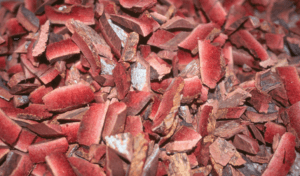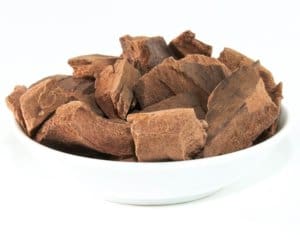Indigenous exclusively to the Amazon rainforests of Bolivia, Columbia, Ecuador, Peru, and Venezuela, the magnificent Chu Chu Huasi tree grows to heights of nearly 100 feet. With a wide canopy, large leaves up to a foot in diameter, and dainty white flowers, it may be easy to miss the substantial strength of its reddish-brown bark.
 It is for its bark that indigenous people of the Amazon sought for centuries to provide relief for body pains and to increase physical endurance.1 Chu Chu Huasi, in fact, means, “trembling back” because natives used the bark to give relief and help with sore muscles or joint stiffness after a hard days work, or as a tea or topical lotion upon rising the morning.2
It is for its bark that indigenous people of the Amazon sought for centuries to provide relief for body pains and to increase physical endurance.1 Chu Chu Huasi, in fact, means, “trembling back” because natives used the bark to give relief and help with sore muscles or joint stiffness after a hard days work, or as a tea or topical lotion upon rising the morning.2
The Botanical
Chu Chu Huasi is one of the greater known botanicals of the Amazon. One of our picks for the top 100 Amazon botanicals of all time. It’s full name is Maytenus macrocarpa and is part of the family Celastraceae.3 Celastraceae encompass about 55 genera of woody vines, shrubs, and trees native in tropical and temperate zones.4 The trees are typically found in lowland tropical rainforests but have been located in areas up to 2000 meters above sea level.5 Extracts and compounds made from the leaves, roots, and stem bark offer a wide range of astounding properties that make it one of the most popular and studied botanicals .6 Indeed, Songs, stories, myths and legends referring to Chu chu huasi’s great powers are common knowledge to denizens of the deep jungle, young and old.
Chu Chu Huasi’s Phytochemistry
Scientists worldwide continue to study the composition of Chu Chu Huasi and the impact of its chemical makeup. One of the most significant types of compounds identified is a variety of triterpenes. According to research conducted by a Milan Malanik et. al. in 2019, “Several studies described the presence of mainly tetracyclic dammarane and pentacyclic friedelane triterpenes, and to a lesser extent quinonmethide, lupane, and oleane derived compounds. Another very interesting group of compounds obtained from M. macrocarpa consists of dihydro-β-agarofuran sesquiterpenes.”7 A complete table of Chu Chu Huasi’s phytochemistry can be found here.
Properties for Mankind
In Peru, the native Shipibo and a dozen other indigenous clans use Chu Chu Huasi’s bark as a general tonic.8 Deep in the jungle an entire industry revolves around it; with drinks, lotions and potions being made in the tens of tons annually. The primary uses of Chu Chu Huasi as a general tonic to support overall body functions and increase strengths and balance.9
Get Started with Chu Chu Huasi Extract Today
 Seeking relief from minor body pains? Wish you had greater strength in your back? Adding 10-15 drops of our Liquid Extract may help you achieve a healthier, more pain-free life.
Seeking relief from minor body pains? Wish you had greater strength in your back? Adding 10-15 drops of our Liquid Extract may help you achieve a healthier, more pain-free life.
Easily add Chu Chu Huasi to your daily regimen with Herbs America’s Chu Chu Huasi Liquid Extract. Our product is made from 100% Chu Chu Huasi bark and is combined with 35-40% organic alcohol and distilled water. CLICK HERE to order Chu Chu Huasi Liquid Extract today!
Taylor, Leslie. The Healing Power of the Rainforest Herbs, 2005, Text reprinted at: https://rain-tree.com/chuchuhuasi.htm. ↩
Rainforest Healing Center, Peru. https://rainforesthealingcenter.com/master-plant-isolation-diet/. ↩
Phyto Chemical Interactions Database. https://www.genome.jp/db/pcidb/kna_species/953. ↩
“Celastraceae.” Encyclopedia Brittanica, online edition, https://www.britannica.com/plant/Celastraceae. ↩
Malanik, Milan et. al., “Maytenus macrocarpa (Ruiz & ave.) Briq.: Phytochemistry and Pharmacological Activity,” Molecules, June 29, published online at https://www.ncbi.nlm.nih.gov/pmc/articles/PMC6630539/. ↩
Malanik, Milan et. al., “Maytenus macrocarpa (Ruiz & ave.) Briq.: Phytochemistry and Pharmacological Activity,” Molecules, June 29, published online at https://www.ncbi.nlm.nih.gov/pmc/articles/PMC6630539/. ↩
Malanik, Milan et. al., “Maytenus macrocarpa (Ruiz & ave.) Briq.: Phytochemistry and Pharmacological Activity,” Molecules, June 29, published online at https://www.ncbi.nlm.nih.gov/pmc/articles/PMC6630539/. ↩
Hendricks, Steve. “In the Jungle with Dr. Feelgood,” Outside Magazine, December 15, 2013, https://www.outsideonline.com/1920556/jungle-dr-feelgood. ↩
Taylor, Leslie. The Healing Power of the Rainforest Herbs, 2005, Text reprinted at: https://rain-tree.com/chuchuhuasi.htm. ↩

Reader Interactions